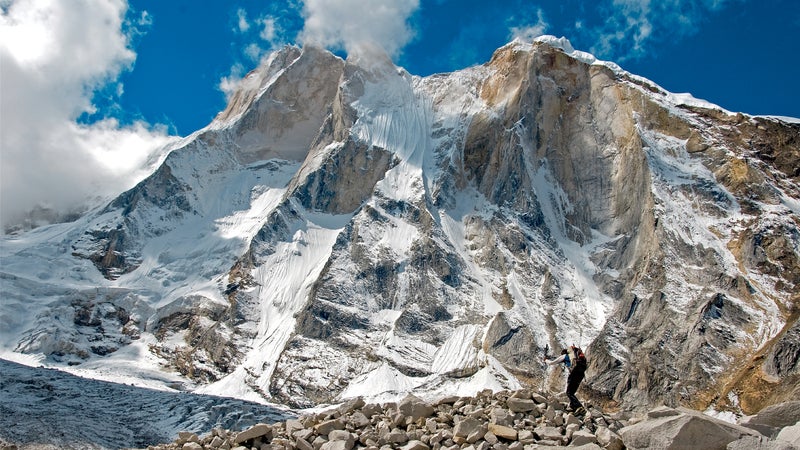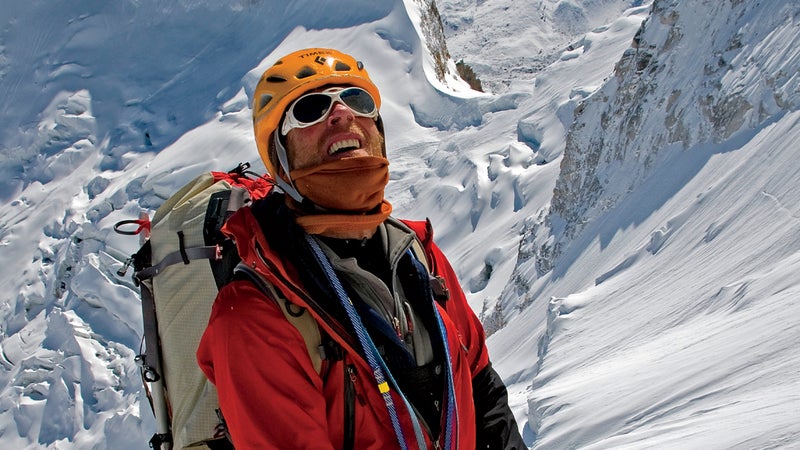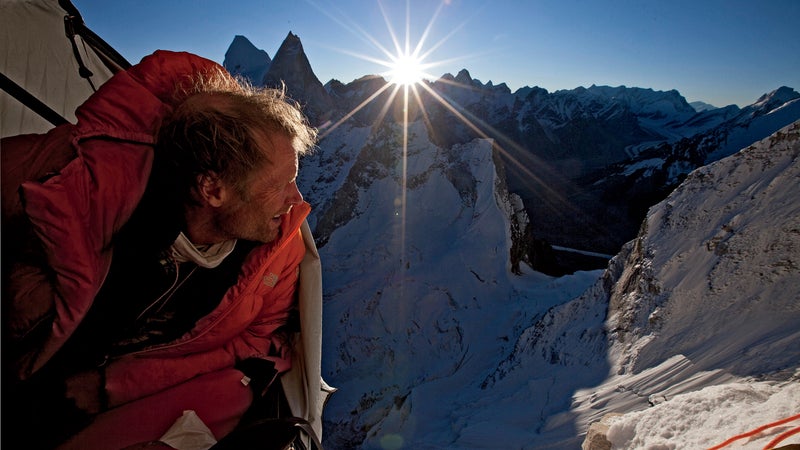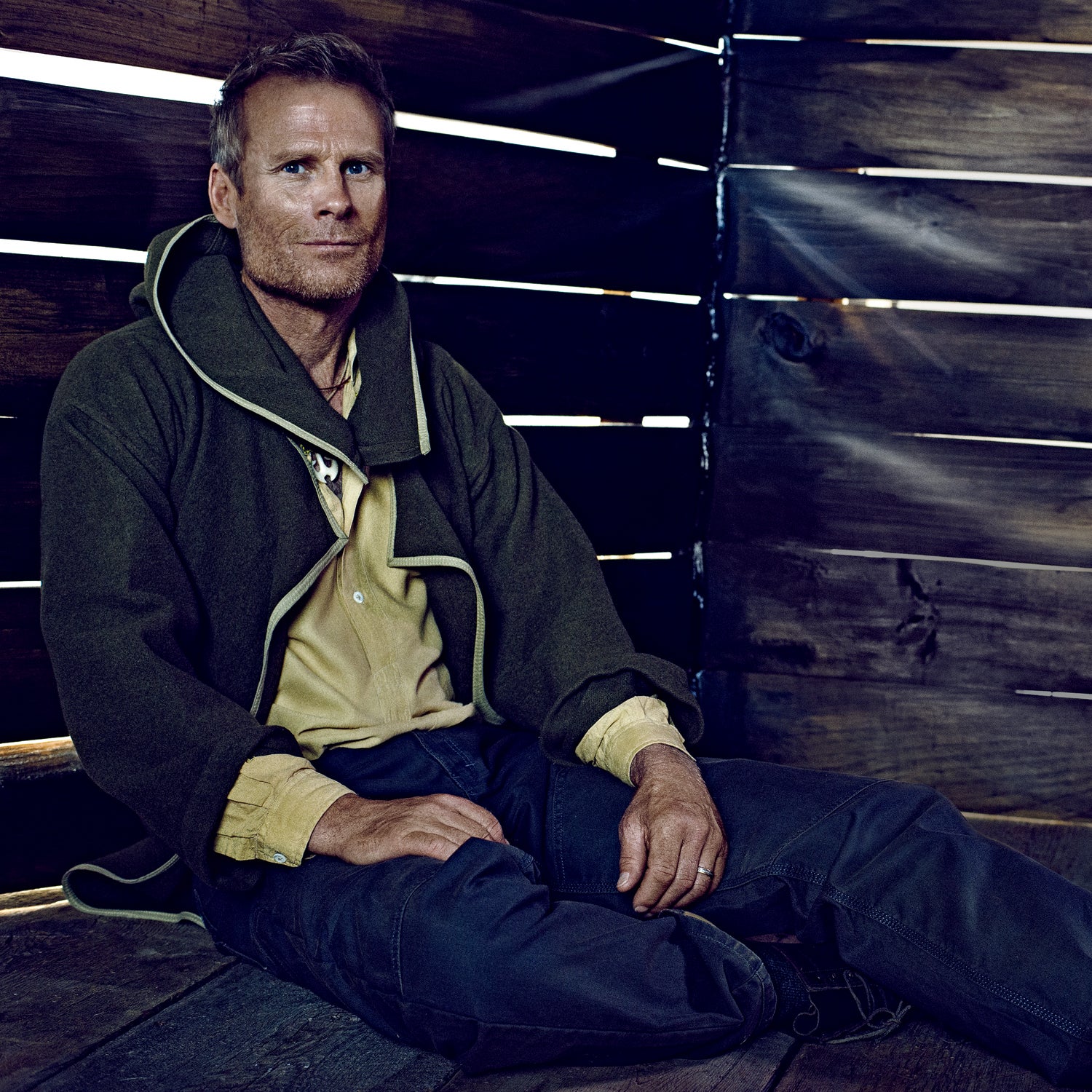As a genre, climbing films are a risky enterprise, pocked with philosophical crevasses, hackneyed themes, and obvious pitfalls: you need to get outside your comfort zone; it isn’t so much the fear of dying but of not actually living; it’s the journey not the destination. Climbers are both the originators and eternal standard bearers of the empty truism, beginning with Everest pioneer George Mallory’s 1924 catchphrase “Because it’s there.”
Meru, the new climbing documentary that will see wide theatrical release in August, avoids these tired expressions but manages to evoke the feelings that inspire them. The film, codirected by the husband and wife team of climber Jimmy Chin and filmmaker Elizabeth Chai Vasarhelyi (Youssou Ndour: I Bring What I Love), follows Chin and his North Face–sponsored teammates Conrad Anker and Renan Ozturk as they try—on two expeditions, in 2008 and 2011—to ascend 21,000-foot Meru Central via its Shark’s Fin feature, a 1,500-foot blade of granite in India’s Garhwal Himalaya range. At the time, the route was widely believed to be unclimbable, and the idea that a movie about attempting it could be anything more than a solid entry on the adventure-film circuit was just an afterthought. In fact, Chin had an earlier version of Meru rejected outright by Sundance in 2011. The following year he met Vasarhelyi, who helped him fully realize his vision for a story of Meru that was actually the story of Conrad Anker.

Then, when Meru won the audience award at its Sundance premiere in January—an honor that typically presages Oscar nominations, as was the case with 2013’s The Square—Chin realized that he’d created more than a climbing film. “I finally said what I’ve been trying to say for so long,” says Chin of the effort. It’s a 90-minute explanation of why he and his friends risk so much, and it succeeds not because the climbing is crazy—though it is—but because it’s a well-told coming of age for three mountain-obsessed men who refuse to give up on their dream despite the demands of adulthood. Rather than try to boil down the feeling into something pithy, the film is an incremental meditation.
“Meru is the culmination of all I’ve done and all I’ve wanted to do,” says Anker in one of the opening interviews. Anker’s wildly successful and tragic climbing life sits at the center of the movie. Meru tells the story of all three men but connects them with Anker’s personal history: of losing his climbing partner Alex Lowe in a Himalayan avalanche in 1999 and then marrying Lowe’s widow and adopting his three children. Anker’s first mentor, the late Terrence “Mugs” Stump, tried the climb in 1988 and failed. Since then, at least three other top alpinists have thrown themselves at the mountain. Stump died while guiding clients on Denali in 1992, and Anker had it in his head to pick up where his friend left off. He tried it for the first time in 2003 with Americans Doug Chabot and Bruce Miller.
The movie opens with a grim-looking scene of a snowbound portaledge—a custom-made tent that dangles from the side of the mountain like the high-altitude love child of a Murphy bed and a prison cell. It was 2008, the team’s first attempt on the mountain. They’d brought a week’s worth of food but ended up spending 19 days on the wall, seeing only what Anker called “the inside of a Ping-Pong ball.”

Because the satellite phone in the haul bag wasn’t functioning, the men had forced their loved ones back home to simply wait and hope that they had hit some nonfatal snag that kept them out later than expected. But despite such a long effort, they came up just short of the summit before turning back. Part of being a top alpinist is understanding how far you can push it and still make it home, explains writer Jon Krakauer, whose interviews throughout the film help translate the climbing world into plain English.
“Some of the best climbers have tried and failed on this route,” he explains. “You can’t just be a good ice climber. You can’t just be good at altitude. You can’t just be a good rock climber. You’ve gotta be able to do ice climbing, mixed climbing, and you’ve got to be able to do big-wall climbing at 20,000 feet. It’s all that stuff wrapped in one package that’s defeated so many good climbers and will probably defeat you and maybe will defeat everybody for all time. That, to a certain kind of mindset, is an irresistible appeal.”
But even with the top so close, the men called it quits: “Hundred meters short of the summit,” says Chin to Ozturk’s camera on the mountain. “We just don’t have the safety margin to make it.”
Part of the difficulty of making a movie like Meru attractive to mainstream audiences is persuading people that the mountain is as worthy of their interest as Everest and K2. The world of climbing films breaks pretty cleanly around this distinction. There are the big-peak climbs in service of a film production—think Everest in Imax, Vertical Limit, Discovery Channel’s Everest: Beyond the Limit. They make money. Sometimes a lot of money. And then there are the soulful documentaries about hardmen on obscure mountains that excite the climbing world but bankrupt their directors.
Meru might be the first film since Touching the Void—the horrifying documentary chronicling Joe Simpson’s survival story, in which Simon Yates has no choice but to cut the rope as a battered Simpson dangles from it—that bridges those worlds.
If life on the mountain seems difficult for the three main characters in Meru, it’s nothing compared with their near misses back in the world. For Anker, the road from dirtbag to professional climber to mentor has been a long one.
In May of 1999, working as part of a seven-man research expedition trying to find out what became of the 1924 British Mount Everest expedition’s summit party, Anker discovered the body of George Mallory, who had been missing high on the mountain’s north slopes since he and partner Sandy Irvine disappeared there 75 years earlier. It was a career high point that was followed only months later by Anker’s nadir. That October, Anker joined an expedition led by his regular climbing partner and fellow North Face ambassador Alex Lowe to try and make the first American ski descent of an 8,000-meter peak: Tibet’s 26,335-foot Shishapangma. During an early reconnaissance hike out of base camp, an avalanche began high above the team and swept down on them. “The compression of time one experiences when you’re a small person underneath this huge avalanche is amazing,” Anker later wrote.
Lowe and Aspen-based cameraman Dave Bridges were killed and never found. Anker, who ran in a different direction and lay down before the blast hit, survived with minor injuries. In their shared grief, Anker and Lowe’s widow, Jennifer, fell in love, got married in 2001, and raised the three Lowe boys, Max, Sam, and Isaac, all while Anker continued to pursue a dangerous career as one of the world’s top alpinists. In a 2001 profile in Outside, Anker acknowledged the difficult position he found himself in, still wanting to push his luck while now being responsible for four other people. “I’ve gotta keep my ass really safe,” he told writer Daniel Duane.

Meanwhile, Chin and Ozturk each had near death experiences in the lull between the 2008 Meru expedition and the team’s return in 2011. In March of 2011, Chin, who is among a handful of people to have skied from the summit of Everest, invited Ozturk on a shoot in the Jackson Hole, Wyoming, backcountry with professional snowboarders Jeremy Jones and Xavier de Le Rue. Ozturk isn’t much of a skier. During the descent toward the filming location, Ozturk hooked an edge and tumbled over a cliff, landing on his head. He was airlifted to Idaho Falls with a fractured skull and the same vertebral artery rupture that would kill halfpipe ski star and Olympic hopeful Sarah Burke in 2012. Just four days later, Chin, who returned to the film project, was caught by a Class IV avalanche that swept him a thousand feet downslope but somehow left him only half-buried. After Ozturk’s injury, Chin had bought his first ski helmet, which may have saved his life.
That these three—one of them only five months out from a life-threatening injury—would go back to Meru that fall speaks to a kind of obsession bordering on the pathological. But it’s one that Meru manages to explain, even if the movie makes you want to shout at the screen as if the three men are coeds reentering the haunted house they’ve just escaped from.
Even now, 16 years after Lowe’s death on Shishapangma, Anker’s late partner still appears to him in dreams. In February, after Meru’s Sundance premier, Anker was on a photo-shoot expedition in Nepal’s Langtang region. Langtang was the area hardest hit by Nepal’s devastating 7.8-magnitude quake; the valley is just over the border from Shishapangma. “I saw the peak that had the avalanche,” says Anker. “I couldn’t see down into the runout zone, but I saw the serac that cut loose. It was the closest I had been to being with Alex since his death. I had a super intense dream when I was over there.”
In the dream, Anker was at a speaking engagement. Lowe walked into the room, and immediately Anker broke down and fell to his knees. “I ask if he sees/knows the story with the boys, sees how they’ve been raised,” Anker wrote in his journal. “I ask him why he disappeared.”
The film manages to explain the team's return to Meru, even if you want to shout at the screen as if the three men are coeds reentering the haunted house they've just escaped from.
In Meru, Anker opens up in a way that he’s never done before, discussing Lowe’s death with Vasarhelyi behind the camera. “Survivor’s guilt is a bear,” he says.
To deal with his inner turmoil, Anker threw himself into his job as a spokesman for the North Face. He saw a therapist, but it wasn’t as helpful as talking to other climbers who had lost friends and also struggled with the internal voice that questioned why one man died and one got to go on living. Gradually, he slid into the mentoring role that Stump, Lowe, and Seth Shaw—another of Anker’s teachers—had played for him. It all came to a head in September 2011 back on Meru.
Early in the trip, the weight of the three men snapped one of the stanchions supporting the portaledge frame. They repaired it with a splint made of ice screws and athletic tape. Inside they spooned, ate little more than couscous, and otherwise suffered by their own doing for seven days to get a shot at the summit. For climbers, the film’s audio of avalanches coming down around them and of Chin tapping on a precarious jumble of unstable blocks with his wall hammer will induce a Pavlovian palm sweat. For everyone else, there’s the moment when singer José González’s “The Storm” comes in just as the men hit their groove on the mountain. Even if you’ve never climbed anything but plastic holds in a gym, you’ll nod and have this little moment of, Yeah, I kinda get it now. On the ledge in the still-frigid sun, Anker is there, exhaling.

This time around, the weather cooperated. Anker led 16 of 29 pitches on the wall. The summit pitch was his by rights, but he handed Chin the rope and said, “Jimmy this is your lead. It’s your turn to take the reins.”
“The scene where Conrad gave me the lead wasn’t in the film until a month before we were done,” says Chin.
“That was such a clear and articulate character moment for Conrad,” says Vasarhelyi. “It brings to life the type of person Conrad is—helping these younger climbers find their voice.”

After summiting Meru, Anker got in touch with David Lama, 24, a Red Bull–sponsored alpinist whose mother is Austrian and whose father is Sherpa. The two plan to join forces on some other big, frigid wall. And in the summer of 2016, Anker and Chin will likely reunite to mentor another well-known climber, Alex Honnold. “It’s time to get Alex in some double boots,” says Anker, referring to the insulated mountaineering footwear that high altitude requires. In 2016, the trio will head to Thalay Sagar, the 22,651-foot pyramid of rock and ice that sits just to the west of Mount Meru.
Anker’s continued success is proof that this type of climbing isn’t just about being strong. It’s about playing the long game. Chin, a father himself now, may have to keep his ass really safe, too, but Anker, 52, shows no signs of slowing. He recognizes that his days of keeping up with men half his age may be numbered. But only just. In April, he told me, “I figure I’ve only got ten more years to do this stuff.”
Grayson Schaffer wrote about ultra-cyclist Juliana Buhring in the May issue.

